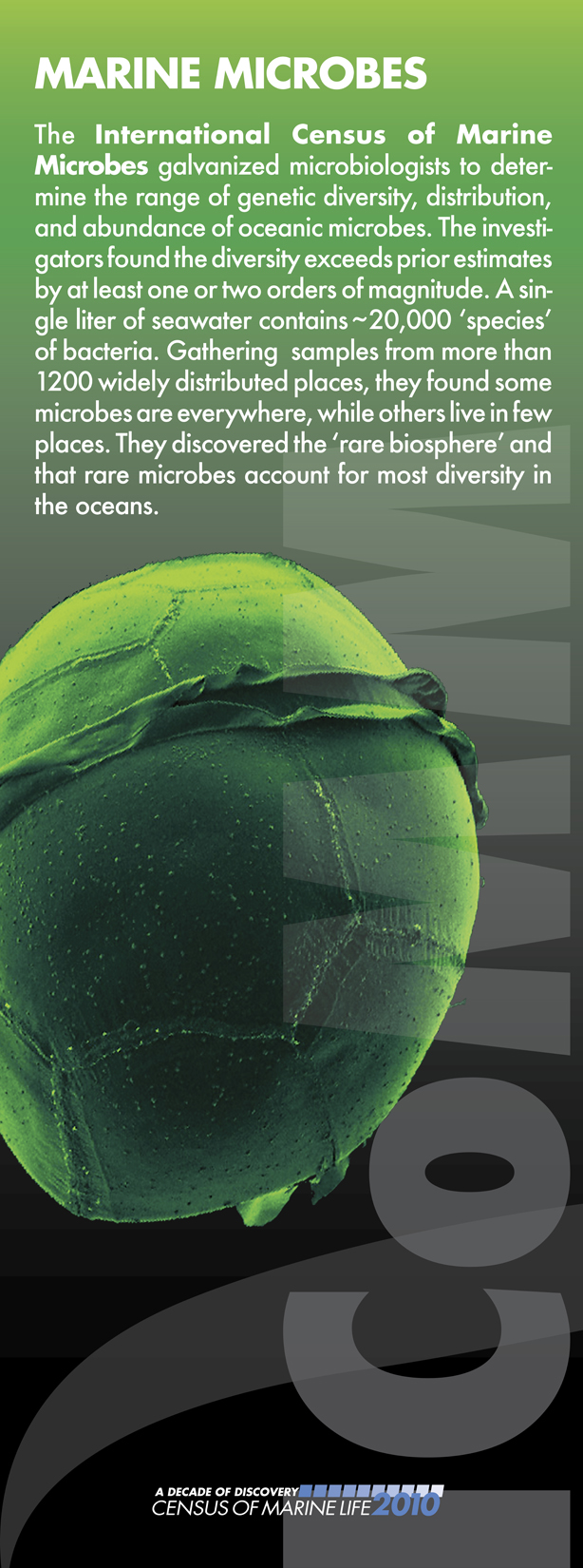International Census of Marine Microbes (ICoMM)
 The oceans worldwide are teeming with microbial life forms invisible to the naked eye. An estimated 3.6 x 1030 microbial cells of untold diversity account for > 90% of the total oceanic biomass. The number of viral particles may be one hundred fold greater. Rich, chemosynthetic microbial communities thrive at deep-sea hydrothermal vents. Abundant archaea, one of the two prokaryotic domains of life, populate oceanic midwaters. Very large populations of phytoplankton including diatoms, dinoflagellates, picoflagellates and cyanobacteria, the primary catalysts in carbon fixation, orchestrate the cycling of nitrogen and form the base of the traditional marine food web. The heterotrophic bacteria belonging to the SAR11 group dominate communities of ocean-surface bacterioplankton while nonphotosynthetic protists (usually single-cell eukaryotes) of unknown diversity control the size of picoplankton (plankton less than 2 µm) populations and regulate the supply of nutrients into the ocean's food webs. Microbes account for the preponderance of life's genetic and metabolic variation, but our understanding of microbial diversity and the evolution of its population structures in the oceans is only fragmentary.
The oceans worldwide are teeming with microbial life forms invisible to the naked eye. An estimated 3.6 x 1030 microbial cells of untold diversity account for > 90% of the total oceanic biomass. The number of viral particles may be one hundred fold greater. Rich, chemosynthetic microbial communities thrive at deep-sea hydrothermal vents. Abundant archaea, one of the two prokaryotic domains of life, populate oceanic midwaters. Very large populations of phytoplankton including diatoms, dinoflagellates, picoflagellates and cyanobacteria, the primary catalysts in carbon fixation, orchestrate the cycling of nitrogen and form the base of the traditional marine food web. The heterotrophic bacteria belonging to the SAR11 group dominate communities of ocean-surface bacterioplankton while nonphotosynthetic protists (usually single-cell eukaryotes) of unknown diversity control the size of picoplankton (plankton less than 2 µm) populations and regulate the supply of nutrients into the ocean's food webs. Microbes account for the preponderance of life's genetic and metabolic variation, but our understanding of microbial diversity and the evolution of its population structures in the oceans is only fragmentary.
The International Census of Marine Microbes (ICoMM) facilitated the inventory of this microbial diversity by implementing a strategy (1) to catalogue all known diversity of single-cell organisms inclusive of the Bacteria, Archaea, Protista and associated viruses, (2) to explore and discover unknown microbial diversity, and (3) to place that knowledge into appropriate ecological and evolutionary contexts.
Project Leaders
Mitchell L. Sogin, United States
Jan W. de Leeuw, The Netherlands
Linda Amaral Zettler, United States
ICoMM Project Website
Project Description
